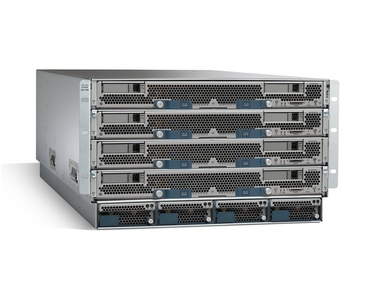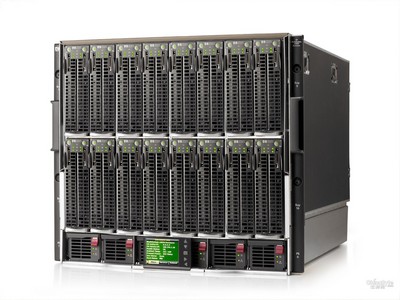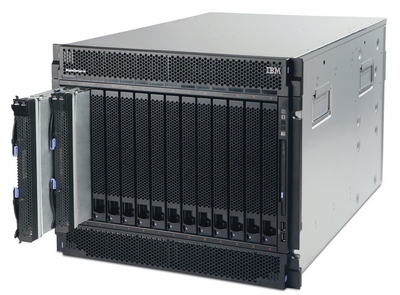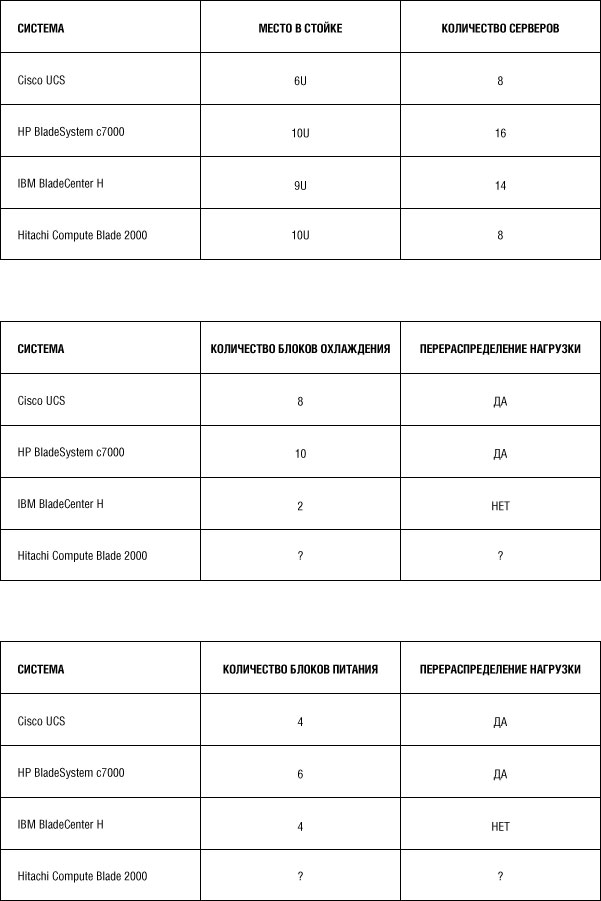HP, IBM, Cisco and Hitachi blade server platforms comparison, part one: hardware design, cooling, power

In this post, broken down for convenience into several parts, I will compare the blade server platforms from the four most successful manufacturers in this segment. The comparison does not claim to be the ultimate truth and is not exhaustive - the most important parameters, namely the hardware design, network infrastructure, features, total system cost and total cost of ownership will be the subject of consideration. For comparison, using open data. Conclusions about the arrangement of places in comparison will be given in the last part of the comparison.
')
Platforms included
Cisco Unified Computing System (UCS)

HP BladeSystem c7000

IBM BladeCenter H

Hitachi Compute Blade 2000

So let's get started.
Hardware design
Cisco Unified Computing System (UCS)
The chassis with servers occupies a 6U rack, while 1 or 2U is required for a central switch. Up to 20 Chassis can be combined into a single system. The central switchboard of the fabric (Fabric Interconnect) is entrusted with the switching and control functions of the distributed system. The servers inside the chassis are scaling units, they are neither managed nor switching domains. The number of servers in the chassis is 4 or 8, depending on the form factor of the specific model.
HP BladeSystem c7000
The chassis with servers occupies 10U rack. The blade infrastructure is traditional, switching is carried out at the chassis level. The number of servers in the chassis is up to 16, depending on the form factor of the specific model.
IBM BladeCenter H
The chassis with servers occupies 9U rack. The blade infrastructure is traditional, switching is carried out at the chassis level. The number of servers in the chassis is up to 14, depending on the form factor of the specific model.
Hitachi Compute Blade 2000
The chassis with servers occupies 10U rack. The number of servers in the chassis is up to 8, depending on the form factor of the specific model.
Cooling
Cisco Unified Computing System (UCS)
There are no control and switching components in UCS, which allows to organize channels for air flow opposite the server slots. For the cooling are responsible 8 blocks of fans, the load can be redistributed between them, depending on the intensity of the specific servers. The chassis cooling system is generally well thought out, with high-density structures, the most efficient servers are effectively cooled.
HP BladeSystem c7000
Up to 2 control modules and up to 8 switching modules are installed in the chassis, so that the surface area available for the chassis surface is seriously reduced. However, for the passage of air flow air ducts are provided with a complex configuration. The tasks of effective air blowing through them are assigned to 10 ventilation blocks with redistribution of load.
IBM BladeCenter H
IBM BladeCenter H installs up to 2 control modules and up to 10 switching modules. This chassis also has a solid backplane of relatively small area, so the cooling air flows through it through difficult trajectories. The IBM BladeCenter blades differ from the other considered blade platforms by the presence of two main fans of large diameter. Such a solution, on the one hand, makes it possible to reduce the rotational speed, but on the other hand, it does not allow flexible load redistribution depending on the heat release of certain servers. Installing high-performance servers can result in the need to leave empty slots for better cooling and a corresponding loss in density.
Hitachi Compute Blade 2000
Unfortunately, in open sources there is no detailed description of the cooling subsystem of this chassis. The appearance of the chassis allows us to conclude with a certain probability that the solution should be close to the HP BladeSystem C7000, including several fan units and a closed rear part of the chassis. The density of the elements of this chassis is lower than that of others, and due to this it is able to cool more efficient servers with top processors.
Nutrition
Cisco UCS
The chassis uses 4 power supplies connected to a common bus that feeds all the active elements of the chassis, including servers and fans. Reservation is implemented according to the N + N scheme, that is, every second block is a backup. It is possible to redistribute the load to increase the overall efficiency of the power system. The nutrition system is generally balanced.
HP BladeSystem c7000
The power supply in the HP BladeSystem c7000 is generally similar to that of the Cisco UCS, but its main difference is in the number of power supply units - there are 6. At the same time, the density of the system is about twice as high, which indicates a slightly lower level of power supply for the server. . But an additional help here is proprietary load balancing technology, it is distributed to each block until a new connection is required, that is, the load level of each block at a selected point in time is close to 100%.
IBM BladeCenter H
IBM BladeCenter H is powered by a zone scheme - each of the two zones in the chassis is powered by its own two power supplies. The zone includes several server and switching blocks, which increases the risks - if both blocks are in the same zone if they fail, a failure can occur.
Hitachi Compute Blade 2000
The most information-closed blade architecture remains a dark horse when using open sources. However, judging by the stated maximum power consumption of 9.6 kW, the chassis has a very good margin of safety. On the other hand, from these figures it can be concluded that energy efficiency is insufficient - in comparison with other platforms, the figure is extremely high.
For clarity, the results are summarized in the table:
Chassis hardware specifications

Source: https://habr.com/ru/post/143999/
All Articles